
The Towne Street Historic District is a historic district on Towne Street, east of Jackson Street in North Attleborough, Massachusetts. Included in the district are numbers 224, 240, 251, and 260 Towne Street. It encompasses a collection of widely spaced rural-suburban houses built in the middle decades of the 19th century. The district was added to the National Register of Historic Places in 2003.

The Federal Street District is a residential and civic historic district in Salem, Massachusetts, United States. It is an expansion of an earlier listing of the Essex County Court Buildings on the National Register of Historic Places in 1976. In addition to the former county court buildings included in the earlier listing, the district expansion in 1983 encompasses the entire block of Federal Street between Washington and North Streets. It includes buildings from 32 to 65 Federal Street, as well as the Tabernacle Church at 50 Washington Street.
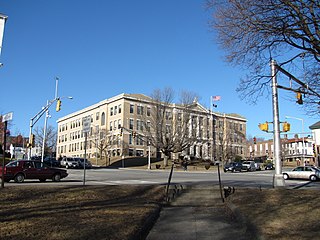
The Main Street Historic District in Haverhill, Massachusetts represents the civic core of Haverhill and a gateway to the city's Highlands neighborhood and lakes district. Overlooking a mid-20th century urban renewal clearance area northeast of the main business and industrial district of the city, it was listed on the National Register of Historic Places in 2003.
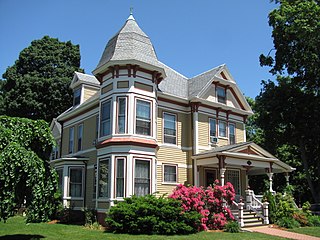
The Woburn Street Historic District of Reading, Massachusetts encompasses a two-block section of late 19th century upper-class housing. The 10-acre (4.0 ha) extends along Woburn Street from Summer Street to Temple Street, and includes sixteen houses on well-proportioned lots along an attractive tree-lined section of the street. The historic district was listed on the National Register of Historic Places in 1985.
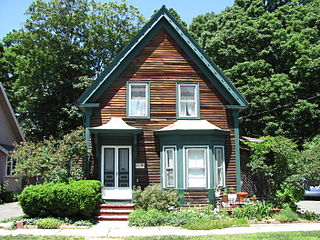
322 Haven Street in Reading, Massachusetts is well preserved cottage with Gothic and Italianate features. Built sometime before 1889, its use of even modest Gothic features is unusual in Reading, where the Gothic Revival was not particularly popular. The house was listed on the National Register of Historic Places in 1984.

The Rev. Thomas Hill House is a historic house in Waltham, Massachusetts. The 2+1⁄2-story wood-frame house was built in 1845 for the noted clergyman Thomas Hill. He was resident at the house while he served as minister of Waltham's First Parish, and for two other periods before his death in 1891. The house is a transitional Greek Revival-Italianate structure, three bays wide, with a side-gable roof that has bracketed eaves.

The Yale Avenue Historic District is a residential historic district near the center of Wakefield, Massachusetts. It encompasses eight residential properties, all but one of which were developed in the 1860s and 1870s, after the arrival of the railroad in town. These properties were built primarily for Boston businessmen, and mark the start of Wakefield's transition to a suburb.

The William Griffin Fuller House is a historic house at 32 Franklin Street in Stoneham, Massachusetts. The two-story wood-frame house was built c. 1850 for William Griffin Fuller, a real estate developer and trustee of the Stoneham Five Cent Savings Bank. Its features are transitional, including both Greek Revival and Italianate details. The five-bay facade and single-story porch are Greek Revival, and the bracketing in the eaves and gable ends is Italianate in style.

The Perez Smith House was a historic house at 46 Lincoln Street in Waltham, Massachusetts. The 2½ story wood-frame house was built in 1851 and was one of the city's finest transitional Greek Revival/Italianate houses. It had a typical Italianate three-bay facade, deep cornice with decorative brackets, and round-arch windows in the gable. It also had Greek Revival pilastered cornerboards, and its center entry was flanked by sidelight windows and topped by a transom window and paneled sunburst. Its windows were topped by heavy corniced lintels.

The North Lexington Street Historic District is a residential historic district at 508–536 North Lexington Street in Waltham, Massachusetts. It consists of a cluster of four houses and their associated outbuildings, built around the turn of the 20th century, and unusual for its state of cohesion and preservation given the busy nature of Lexington Street. Three houses are Colonial Revival in styling, and 528 Lexington is an 1873 Second Empire house. The house at 508 Lexington was built in 1865 and extensively restyled in 1905; it retains some Italianate styling. Particularly rare in Waltham is the converted barn at 526 Lexington Street. This cluster of buildings was traditionally associated with the Piety Corner area, but is now separated from it by a significant number of more modern buildings.

The Robert Murray House is a historic house at 85 Crescent Street in Waltham, Massachusetts. The 2+1⁄2-story wood-frame house was built c. 1859, and was one of the earliest Italianate Victorian houses built in the area. It has classic Italianate styling, with a three-bay facade that has a small centered cross gable, and paired brackets in the eaves and gable ends. Its entry is sheltered by a porch with fluted Doric columns topped by a dentillated pediment.
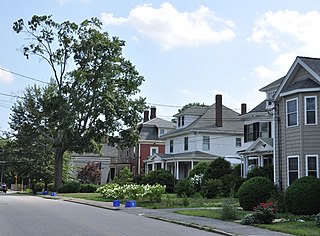
The Lyman Street Historic District is a historic district roughly encompassing Lyman Street between Church and Main Streets in Waltham, Massachusetts. Lyman Street was laid out in 1826 by Theodore Lyman, owner of The Vale, a country estate just to the north. Residential development took place along the street roughly between 1840 and 1900, resulting in a series of fashionable houses in a variety of 19th century architectural styles on the west side of the street. The district was listed on the National Register of Historic Places in 1989.

The East Main Street Historic District is a small residential historic district in Waltham, Massachusetts. It encompasses part of an area that was, before the 1813 construction of the Boston Manufacturing Company further west, developing as a center of the community. Because of the company's economic influence, the center was more fully developed further west, and East Main Street became a fashionable area for upper class housing. The four houses on the south side of East Main Street between Townsend Street and Chamberlain Terrace are a well-preserved remnant of this later period. The district was listed on the National Register of Historic Places in 1989.

The Dunbar–Stearns House is a historic house at 209 Linden Street in Waltham, Massachusetts. This 2+1⁄2-story wood-frame house was built c. 1846 by Peter Dunbar, and was originally Greek Revival in character. It had a fully pedimented gable, with a single-story porch that was supported by columns that apparently wrapped around the building. The house was purchased in 1892 by Joseph Stearns, who had the house completely remodeled to achieve its present Queen Anne styling. It was enlarged to the sides by incorporating the area of the side porticos, a turret was added to the front, and the pedimented gable was covered with decorative shingle styling. Interior alterations into the new style were equally extensive.
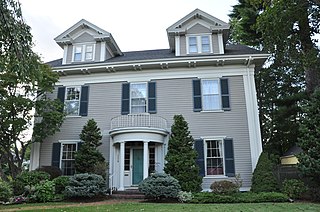
The Joseph Andrews House is a historic house at 258 Linden Street in Waltham, Massachusetts. Built in 1851, it is one of the city's oldest examples of Italianate architecture, and was one of the first houses built in Linden Street. It was listed on the National Register of Historic Places in 1989.

The House at 7 Salem Street in Wakefield, Massachusetts is a transitional Greek Revival/Italianate style house built c. 1855–57. The 2+1⁄2-story wood-frame house has a typical Greek Revival side hall plan, with door and window surrounds that are also typical to that style. However, it also bears clear Italianate styling with the arched window in the gable, and the paired brackets in the eaves. A single-story porch wraps around the front and side, supported by simple square columns. Its occupant in 1857 was a ticket agent for the Boston and Maine Railroad.

The House at 309 Waltham Street in Newton, Massachusetts, is a well-preserved high style Greek Revival house. The 2+1⁄2-story house was built c. 1835; it has a classic Greek temple front, with two-story Ionic columns supporting an entablature and pedimented gable, with a balcony at the second level. Single-story Ionic columns support a porch running along the left side of the house. It is one six documented temple-front houses in the city.

The E. B. Cummings House is a historic house at 52 Marcy Street in Southbridge, Massachusetts. Built in the 1870s, it is an unusually late example of Greek Revival architecture with Italianate embellishments and later Victorian additions. The house was listed on the National Register of Historic Places on June 22, 1989.

The Edwin W. Marsh House is a historic house at 17 Marsh Street in Quincy, Massachusetts. The 1+1⁄2-story five-bay wood-frame house was built c. 1851, and had a rear ell. The Cape style cottage had vernacular Greek Revival styling, including corner pilasters. It had a bracketed entry portico that was probably added during the Italianate period (1860s-70s).

The House at 53 Linden Street in Brookline, Massachusetts, is a well-preserved local example of transitional Greek Revival-Italianate styling. The 2+1⁄2-story wood-frame house was built c. 1843–44 by John Faxon. It has a pedimented gable front with pilasters, but is L-shaped and has round-arch windows in its gables, both Italianate features. It is one of four surviving Greek Revival houses in the neighborhood, which was developed beginning in 1840.























